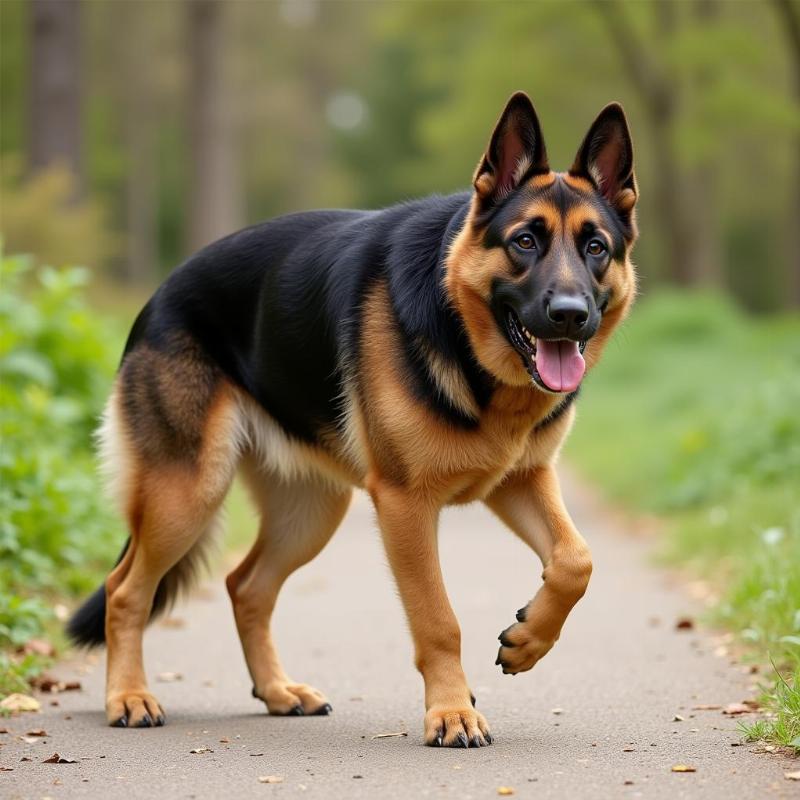German Shepherd Dogs (GSDs), known for their intelligence and loyalty, are unfortunately predisposed to certain back leg problems. Understanding these potential issues is crucial for any GSD owner in the US, enabling them to provide the best possible care and ensure a happy, active life for their canine companion. This article will delve into common german shepherd dog back leg problems, covering causes, symptoms, diagnosis, treatment options, and preventive measures.
Common Back Leg Problems in German Shepherds
GSDs are particularly susceptible to a few specific back leg issues, often due to their size, rapid growth, and genetic predispositions. These include hip and elbow dysplasia, degenerative myelopathy, and cruciate ligament tears. Recognizing the signs early can make a significant difference in your dog’s comfort and long-term health. Don’t hesitate to consult with your veterinarian if you notice anything unusual.
Hip and Elbow Dysplasia
Hip and elbow dysplasia are inherited conditions affecting the joints. In dysplasia, the joint doesn’t develop properly, leading to instability, pain, and arthritis. This can manifest as lameness, stiffness, difficulty rising, and a reluctance to exercise. Severity varies, and early diagnosis is key for effective management. Treatment options range from pain management and physical therapy to surgery in severe cases.
Degenerative Myelopathy (DM)
DM is a progressive neurological disease affecting the spinal cord. While not exclusive to GSDs, they are a high-risk breed. DM gradually weakens the hind legs, leading to difficulty walking, dragging paws, and eventual paralysis. Sadly, there is no cure for DM, but supportive care can improve the dog’s quality of life.
 German Shepherd with degenerative myelopathy
German Shepherd with degenerative myelopathy
Cruciate Ligament Tears
Similar to humans, dogs can tear the ligaments in their knees. Cruciate ligament tears are common in active breeds like GSDs and can occur suddenly during exercise or gradually due to degeneration. Symptoms include sudden lameness, swelling, pain, and instability in the knee joint. Surgical repair is often necessary to restore normal function.
Diagnosing and Treating Back Leg Issues
If your GSD shows signs of back leg problems, a prompt veterinary visit is essential. Your vet will perform a physical exam and may recommend X-rays, CT scans, or MRI to determine the underlying cause. dog not using back legs Treatment varies depending on the diagnosis and can include medications for pain and inflammation, physical therapy, weight management, joint supplements, and surgery.
Preventing Back Leg Problems in German Shepherds
While some genetic predispositions can’t be avoided, several proactive steps can minimize the risk of back leg problems in your GSD. Maintaining a healthy weight, providing appropriate exercise, and feeding a balanced diet are crucial. harness for deep chested dogs Avoiding high-impact activities, especially during puppyhood, can also protect developing joints. is it bad for dogs to jump off beds Regular veterinary checkups are essential for early detection and intervention. dogs back legs cross when walking
Conclusion
German Shepherd dog back leg problems can significantly impact their quality of life. By understanding the common issues, recognizing early signs, and taking preventive measures, GSD owners can help their loyal companions live full and active lives. Early diagnosis and appropriate treatment are key to managing these conditions effectively. Don’t hesitate to consult with your veterinarian if you notice any changes in your GSD’s gait or mobility. dog is dragging back legs
FAQ
-
What are the first signs of hip dysplasia in a German Shepherd? Early signs can include stiffness, lameness, especially after rest, difficulty rising, and a “bunny hopping” gait.
-
Is degenerative myelopathy painful for dogs? DM is not typically considered a painful condition, but it can cause discomfort and frustration as mobility decreases.
-
How can I help my GSD recover from a cruciate ligament tear? Strict rest, pain medication, and often surgery are necessary for recovery. Physical therapy is also crucial for rehabilitation.
-
What kind of exercise is best for a GSD with back leg problems? Low-impact activities like swimming, short walks on soft surfaces, and controlled leash walks are generally recommended.
-
Are there any supplements that can help with joint health in GSDs? Glucosamine and chondroitin supplements are often recommended for joint support, but always consult with your vet before starting any new supplement.
-
How much exercise should a GSD puppy get to prevent joint problems? Avoid overexertion and high-impact activities. Short, frequent play sessions and walks are preferable to long, strenuous exercise.
-
Can diet affect the development of back leg problems in GSDs? A balanced diet, especially during puppyhood, is essential for healthy joint development. Maintaining a healthy weight throughout life is also crucial.
Beautdogs.us is your premier online resource for comprehensive German Shepherd care, breed information, and product recommendations. We cater to both new and experienced dog owners, offering expert advice and insights into the world of GSD ownership. For further information and personalized guidance, please contact us at [email protected] or call us at +1 501-555-7529. Beautdogs.us is committed to helping you provide the best possible care for your beloved GSD.